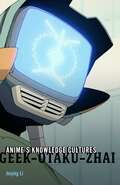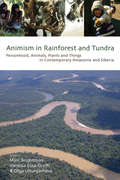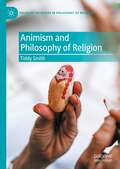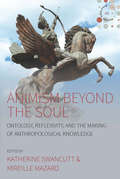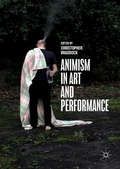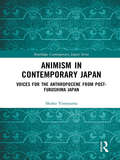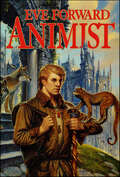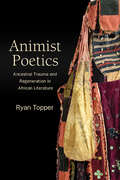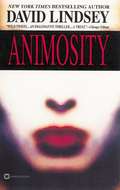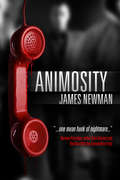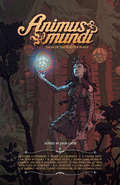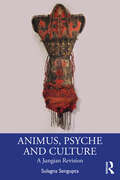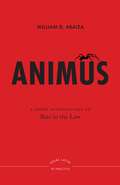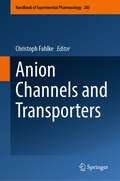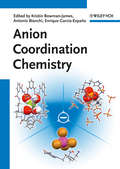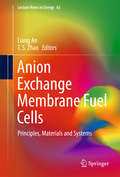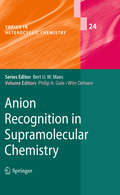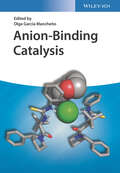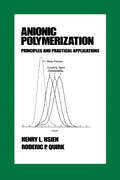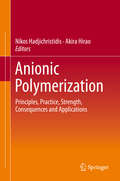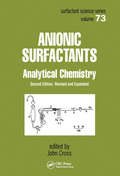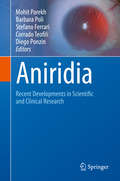- Table View
- List View
Anime's Knowledge Cultures: Geek, Otaku, Zhai
by Jinying LiUnlocking the technosocial implications of global geek cultures Why has anime, a &“low-tech&” medium from last century, suddenly become the cultural &“new cool&” in the information age? Through the lens of anime and its transnational fandom, Jinying Li explores the meanings and logics of &“geekdom&” as one of the most significant sociocultural groups of our time. In Anime&’s Knowledge Cultures, Li shifts the center of global geography in knowledge culture from the computer boys in Silicon Valley to the anime fandom in East Asia. Drawing from film studies, animation studies, media theories, fan studies, and area studies, she provides broad cultural and theoretical explanations of anime&’s appeal to a new body of tech-savvy knowledge workers and consumers commonly known as geeks, otaku, or zhai. Examining the forms, techniques, and aesthetics of anime, as well as the organization, practices, and sensibilities of its fandom, Anime&’s Knowledge Cultures is at once a theorization of anime as a media environment as well as a historical and cultural study of transnational geekdom as a knowledge culture. Li analyzes anime culture beyond the national and subcultural frameworks of Japan or Japanese otaku, instead theorizing anime&’s transnational, transmedial network as the epitome of the postindustrial knowledge culture of global geekdom. By interrogating the connection between the anime boom and global geekdom, Li reshapes how we understand the meanings and significance of anime culture in relation to changing social and technological environments.
Anime’s Media Mix: Franchising Toys and Characters in Japan
by Marc SteinbergIn Anime&’s Media Mix, Marc Steinberg convincingly shows that anime is far more than a style of Japanese animation. Beyond its immediate form of cartooning, anime is also a unique mode of cultural production and consumption that led to the phenomenon that is today called &“media mix&” in Japan and &“convergence&” in the West. According to Steinberg, both anime and the media mix were ignited on January 1, 1963, when Astro Boy hit Japanese TV screens for the first time. Sponsored by a chocolate manufacturer with savvy marketing skills, Astro Boy quickly became a cultural icon in Japan. He was the poster boy (or, in his case, &“sticker boy&”) both for Meiji Seika&’s chocolates and for what could happen when a goggle-eyed cartoon child fell into the eager clutches of creative marketers. It was only a short step, Steinberg makes clear, from Astro Boy to Pokémon and beyond.Steinberg traces the cultural genealogy that spawned Astro Boy to the transformations of Japanese media culture that followed—and forward to the even more profound developments in global capitalism supported by the circulation of characters like Doraemon, Hello Kitty, and Suzumiya Haruhi. He details how convergence was sparked by anime, with its astoundingly broad merchandising of images and its franchising across media and commodities. He also explains, for the first time, how the rise of anime cannot be understood properly—historically, economically, and culturally—without grasping the integral role that the media mix played from the start. Engaging with film, animation, and media studies, as well as analyses of consumer culture and theories of capitalism, Steinberg offers the first sustained study of the Japanese mode of convergence that informs global media practices to this day.
Animism In Rainforest And Tundra
by Vanessa Elisa Grotti Marc Brightman Olga UlturgashevaAmazonia and Siberia, classic regions of shamanism, have long challenged 'western' understandings of man's place in the world. By exploring the social relations between humans and non-human entities credited with human-like personhood (not only animals and plants, but also 'things' such as artifacts, trade items, or mineral resources) from a comparative perspective, this volume offers valuable insights into the constitutions of humanity and personhood characteristic of the two areas. The contributors conducted their ethnographic fieldwork among peoples undergoing transformative processes of their lived environments, such as the depletion of natural resources and migration to urban centers. They describe here fundamental relational modes that are being tested in the face of change, presenting groundbreaking research on personhood and agency in shamanic societies and contributing to our global understanding of social and cultural change and continuity.
Animism and Philosophy of Religion (Palgrave Frontiers in Philosophy of Religion)
by Tiddy SmithMainstream philosophy of religion has persistently failed to engage seriously or critically with animist beliefs and practices. The field that is now called "philosophy of religion" could quite easily be renamed "philosophy of theism" with few lecturers on the subject having to change their lecture notes. It is the aim of this volume to rectify that failure and to present animism as a live option among the plethora of religious worldviews. The volume addresses four major questions: 1. What is this thing called "animism"? 2. Are there any arguments for or against animist belief and practice? 3. What is the relationship between animism, naturalism, and the sciences? And 4. Should we take animism seriously? Animism and Philosophy of Religion is intended to be the first authoritative scholarly volume on the issue of animism and its place in the philosophy of religion. Ambitiously, it aims to act as the cornerstone volume for future work on the subject and as a key text for courses engaging with the subject.
Animism and the Question of Life: Animism And The Question Of Life (Routledge Studies in Anthropology)
by Istvan PraetThe central purpose of this book is to help change the terms of the debate on animism, a classic theme in anthropology. It combines some of the finest ethnographic material currently available (including firsthand research on the Chachi of Ecuador) with an unusually broad geographic scope (the Americas, Asia, and Africa). Edward B. Tylor originally defined animism as the first phase in the development of religion. The heyday of cultural evolutionism may be over, but his basic conception is commonly assumed to remain valid in at least one respect: there is still a broad consensus that everything is alive within animism, or at least that more things are alive than a modern scientific observer would allow for (e.g., clouds, rivers, mountains) It is considered self-evident that animism is based on a kind of exaggeration: its adherents are presumed to impute life to this, that and the other in a remarkably generous manner. Against the prevailing consensus, this book argues that if animism has one outstanding feature, it is its peculiar restrictiveness. Animistic notions of life are astonishingly uniform across the globe, insofar as they are restricted rather than exaggerated. In the modern Western cosmology, life overlaps with the animate. Within animism, however, life is always conditional, and therefore tends to be limited to one’s kin, one’s pets and perhaps the plants in one’s garden. Thus it emerges that "our" modern biological concept of life is stranger than generally thought.
Animism beyond the Soul: Ontology, Reflexivity, and the Making of Anthropological Knowledge (Studies in Social Analysis #6)
by Katherine Swancutt Mireille MazardHow might we envision animism through the lens of the ‘anthropology of anthropology’? The contributors to this volume offer compelling case studies that demonstrate how indigenous animistic practices, concepts, traditions, and ontologies are co-authored in highly reflexive ways by anthropologists and their interlocutors. They explore how native epistemologies, which inform anthropological notions during fieldwork, underpin the dialogues between researchers and their participants. In doing so, the contributors reveal ways in which indigenous thinkers might be influenced by anthropological concepts of the soul and, equally, how they might subtly or dramatically then transform those same concepts within anthropological theory.
Animism in Art and Performance
by Christopher BraddockThis book explores Māori indigenous and non-indigenous scholarship corresponding with the term ‘animism’. In addressing visual, media and performance art, it explores the dualisms of people and things, as well as 'who' or 'what' is credited with 'animacy'. It comprises a diverse array of essays divided into four sections: Indigenous Animacies, Atmospheric Animations, Animacy Hierarchies and Sensational Animisms. Cassandra Barnett discusses artists Terri Te Tau and Bridget Reweti and how personhood and hau (life breath) traverse art-taonga. Artist Natalie Robertson addresses kōrero (talk) with ancestors through photography. Janine Randerson and sound artist Rachel Shearer consider the sun as animate with mauri (life force), while Anna Gibb explores life in the algorithm. Rebecca Schneider and Amelia Jones discuss animacy in queered and raced formations. Stephen Zepke explores Deleuze and Guattari's animist hylozoism and Amelia Barikin examines a mineral ontology of art. This book will appeal to readers interested in indigenous and non-indigenous entanglements and those who seek different approaches to new materialism, the post-human and the anthropocene.
Animism in Contemporary Japan: Voices for the Anthropocene from post-Fukushima Japan (Routledge Contemporary Japan Series)
by Shoko Yoneyama‘Postmodern animism’ first emerged in grassroots Japan in the aftermath of mercury poisoning in Minamata and the nuclear meltdown in Fukushima. Fusing critiques of modernity with intangible cultural heritages, it represents a philosophy of the life-world, where nature is a manifestation of a dynamic life force where all life is interconnected. This new animism, it is argued, could inspire a fundamental rethink of the human-nature relationship. The book explores this notion of animism through the lens of four prominent figures in Japan: animation film director Miyazaki Hayao, sociologist Tsurumi Kazuko, writer Ishimure Michiko, and Minamata fisherman-philosopher Ogata Masato. Taking a biographical approach, it illustrates how these individuals moved towards the conclusion that animism can help humanity survive modernity. It contributes to the Anthropocene discourse from a transcultural and transdisciplinary perspective, thus addressing themes of nature and spirituality, whilst also engaging with arguments from mainstream social sciences. Presenting a new perspective for a post-anthropocentric paradigm, Animism in Contemporary Japan will be useful to students and scholars of sociology, anthropology, philosophy and Japanese Studies.
Animism in Southeast Asia (Routledge Contemporary Southeast Asia Series)
by Guido Sprenger Kaj ArhemAnimism refers to ontologies or worldviews which assign agency and personhood to human and non-human beings alike. Recent years have seen a revival of this concept in anthropology, where it is now discussed as an alternative to modern-Western naturalistic notions of human-environment relations. Based on original fieldwork, this book presents a number of case studies of animism from insular and peninsular Southeast Asia and offers a comprehensive overview of the phenomenon - its diversity and underlying commonalities and its resilience in the face of powerful forces of change. Critically engaging with the current standard notion of animism, based on hunter-gatherer and horticulturalist societies in other regions, it examines the roles of life forces, souls and spirits in local cosmologies and indigenous religion. It proposes an expansion of the concept to societies featuring mixed farming, sacrifice and hierarchy and explores the question of how non-human agents are created through acts of attention and communication, touching upon the relationship between animist ontologies, world religion, and the state. Shedding new light on Southeast Asian religious ethnographic research, the book is a significant contribution to anthropological theory and the revitalization of the concept of animism in the humanities and social sciences.
Animist
by Eve Forward"Forward offers a fresh and imaginative view of magic and mayhem in this first book of a projected trilogy."--Library JournalYoung Alex is a slave. But recognized for his potential as an Animist, he is bought by his college and begins rigorous training. Now, Alex must begin his quest for his Anim-the animal with whom he will bond.Alex hopes it will be an extraordinary creature that will help him earn the money he needs to buy his freedom. Unfortunately, his Anim turns out to be . . . well, not nearly what he had hoped. But as Alex finds himself caught in one misadventure after another, he will learn-and learn to appreciate-that there is more to his Anim than meets the eye.At the Publisher's request, this title is being sold without Digital Rights Management Software (DRM) applied.
Animist Poetics: Ancestral Trauma and Regeneration in African Literature (SUNY series, Philosophy and Race)
by Ryan TopperArgues that African literature conceptualizes trauma and regeneration as a more-than-human process, offering an animist revision of psychoanalysis.Psychoanalytic trauma theory largely disregards African perspectives. Postcolonial criticism often filters these perspectives through a secular humanist lens. Examining how African literature uses animism to address the traumas of colonization, Animist Poetics offers a new understanding of the postcolonial condition. From an animist viewpoint, the self is not an individual but rather a regenerative process linking the living, the dead, and their ecosystems. Looking at poetry, fiction, drama, and visual art—including archival manuscripts by Wole Soyinka and Yvonne Vera—Ryan Topper argues that African literature reinvents these Indigenous ecologies in uniquely modern ways. Animist Poetics takes Indigenous—and literary—knowledge seriously, rethinking the foundations of psychoanalysis and charting new theoretical paths in posthumanism, the environmental humanities, new materialism, biopolitics, and memory studies.
Animosity
by David LindseyRoss Marteau is the toast of the international art world for his sensualsculptures of rich and famous women. But when a long-term relationshipbreaks up badly, he retreats to his Texas hometown -- only to have hisnewfound peace of mind permanently, and profoundly, shattered.One afternoon over lunch, Ross is approached by a woman to whom he feelsan irresistible attraction. She introduces herself as Celeste Lacan andasks him to take on a new commission, a sculpture of her younger sister, Leda, promising that the job will present artistic challenges unlike anyhe has encountered before. Though reluctant, Ross can't help but beintrigued: by Celeste herself and by a photo of Leda's face, a portraitof incomparable beauty.When he meets her, Ross is stunned to discover that Leda's body is asstartlingly unique as her face is beautiful. Just as Celeste predicted, he becomes consumed with portraying the duality of her body... and, perhaps, her soul. At the same time, he becomes increasingly aware thatthe enigmati depth he sees in Celeste is as mesmerizing as thefathomless torment he sees in Leda. Soon he's romantically involved withone sist
Animosity
by James NewmanA bestselling horror author discovers that nothing is more frightening than his own neighbors in this dark tale of psychological suspense.After his wife leaves him for another man, Andrew Holland throws himself into his writing more vigorously than ever. He lives a quiet life in the town of Poinsettia Lane, where his neighbors are proud to know a celebrity author. But all that changes when Andy discovers a murdered child not far from his home.Though the authorities clear Andy of any wrongdoing, the local media suggests eerie connections between his gruesome novels and his tragic discovery. His neighbors start to turn on him. Then the vandalism and threatening phone calls start. Just as Andy begins to wonder if he’ll survive this ordeal with his sanity intact, another child’s body is found. Now Andy wonders if he’ll survive at all.
Animus Mundi: Tales of the Spirit of Place (Tales of the Spirit of Place #2)
by Jaym GatesTales of guardian spirits and divine powers by Seanan McGuire, Ken Liu, Alethea Kontis, Laura Anne Gilman, Scott Edelman and more. Guardian spirits. Divine presences. Demonic powers. Ghosts. The concept of "genius loci" is indeed an ancient one, found in nearly every human mythology. Genius Loci is a huge anthology of 31 all-new fantasy and science fiction stories drawing on the rich tradition of place-as-person. Within its pages, the authors present stories of sentient deserts, beneficent forests, lonely shrubs, and protective planetary spirits, highlighted by the fantastic art of Lisa A. Grabenstetter and Evan M. Jensen., and edited by Jaym Gates.
Animus, Psyche and Culture: A Jungian Revision
by Sulagna SenguptaAnimus, Psyche and Culture takes Carl Jung’s concept of contra-sexual psyche and locates it within the cultural expanse of India, using ethnographic narratives, history, religion, myth, films, biographical extracts to deliberate on the feminine in psychological, social and archetypal realms. Jung’s concept of unconscious contra-sexuality, based on notions of feminine Eros and masculine Logos, was pioneering in his time, but took masculine and feminine to be fixed and essential attributes of gender in the psyche. This book explores the relevance of the animus, examining its rationale in current contexts of gender fluidity. Taking off from Post Jungian critiques, it proposes an exposition of the animus in history, social and religious phenomena, theories of knowledge, psychoid archetype and synchronicity, to grasp its nuances in diverse cultural worlds. This study re-envisions the notion of animus keeping in mind the intricacies of feminine subjectivity and the diversity of cultural worlds where depth psychological ideas are currently emerging. A remarkable reworking of Jungian ideas, this well-researched and important new book will be an insightful read for Jungian analysts and scholars with an interest in cultural and gender studies.
Animus: A Short Introduction to Bias in the Law
by William D. AraizaAn introduction to the legal concept of unconstitutional bias.If a town council denies a zoning permit for a group home for intellectually disabled persons because residents don’t want “those kinds of people” in the neighborhood, the town’s decision is motivated by the public’s dislike of a particular group. Constitutional law calls this rationale “animus.”Over the last two decades, the Supreme Court has increasingly turned to the concept of animus to explain why some instances of discrimination are unconstitutional. However, the Court’s condemnation of animus fails to address some serious questions. How can animus on the part of people and institutions be uncovered? Does mere opposition to a particular group’s equality claims constitute animus? Does the concept of animus have roots in the Constitution?Animus engages these important questions, offering an original and provocative introduction to this type of unconstitutional bias. William Araiza analyzes some of the modern Supreme Court’s most important discrimination cases through the lens of animus, tracing the concept from nineteenth century legal doctrine to today’s landmark cases, including Obergefell vs. Hodges and United States v. Windsor, both related to the legal rights of same-sex couples. Animus humanizes what might otherwise be an abstract legal question, illustrating what constitutes animus, and why the prohibition against it matters more today than ever in our pluralistic society.
Anion Channels and Transporters (Handbook of Experimental Pharmacology #283)
by Christoph FahlkeThis book provides an overview on recent progress in anion channels and transporters. It covers multiple scales of analysis ranging from studying the molecular basis of function at atomic resolution to cellular consequences to channel/transporter dysfunction and approaches to correct such processes by pharmacological intervention. Similar anion channels and transporters are expressed in multiple tissues – often fulfilling similar cellular tasks, but also clearly distinct functions. The aim is to combine work on multiple cell and organ systems.
Anion Coordination Chemistry
by Antonio Bianchi Kristin Bowman-James Enrique Garc 237 A-EspanaBuilding on the pioneering work in supramolecular chemistry from the last 20 years or so, this monograph addresses new and recent approaches to anion coordination chemistry. Synthesis of receptors, biological receptors and metallareceptors, the energetics of anion binding, molecular structures of anion complexes, sensing devices are presented and computational studies addressed to aid with the understanding of the different driving forces responsible for anion complexation. The reader is promised an actual picture of the state of the art for this exciting and constantly evolving field of supramolecular anion coordination chemistry. The topics range from ion channels to selective sensors, making it attractive to all researchers and PhD students with an interest in supramolecular chemistry.
Anion Exchange Membrane Fuel Cells: Principles, Materials And Systems (Lecture Notes In Energy #63)
by Liang An T. S. ZhaoThis book provides a review of the latest advances in anion exchange membrane fuel cells. Starting with an introduction to the field, it then examines the chemistry and catalysis involved in this energy technology. It also includes an introduction to the mathematical modelling of these fuel cells before discussing the system design and performance of real-world systems. <P><P> Anion exchange membrane fuel cells are an emerging energy technology that has the potential to overcome many of the obstacles of proton exchange membrane fuel cells in terms of the cost, stability, and durability of materials. The book is an essential reference resource for professionals, researchers, and policymakers around the globe working in academia, industry, and government.
Anion Recognition in Supramolecular Chemistry (Topics in Heterocyclic Chemistry #24)
by Philip A. Gale Wim DehaenBrett M. Rambo Eric S. Silver Christopher W. Bielawski Jonathan L. Sessler Covalent Polymers Containing Discrete Heterocyclic Anion Receptors Philip A. Gale Chang-Hee Lee Calix[n]pyrroles as Anion and Ion-Pair Complexants Wim Dehaen Calix[n]phyrins: Synthesis and Anion Recognition Hiromitsu Maeda Acyclic Oligopyrrolic Anion Receptors Jeffery T. Davis Anion Binding and Transport by Prodigiosin and Its Analogs Hemraj Juwarker Jae-min Suk Kyu-Sung Jeong Indoles and Related Heterocycles Pavel Anzenbacher Jr. Pyrrole-Based Anion Sensors, Part I: Colorimetric Sensors Pavel Anzenbacher Jr. Pyrrole-Based Anion Sensors, Part II: Fluorescence, Luminescence, and Electrochemical Sensors Ermitas Alcalde Immaculada Dinarès Neus Mesquida Imidazolium-Based Receptors Nathan L. Kilah Paul D. Beer Pyridine and Pyridinium-Based Anion Receptors Kevin P. McDonald Yuran Hua Amar H. Flood 1,2,3-Triazoles and the Expanding Utility of Charge Neutral CHlllAnion Interactions
Anion-Binding Catalysis
by Olga García MancheñoExplores the potential of new types of anion-binding catalysts to solve challenging synthetic problems Anion-Binding Catalysis introduces readers to the use of anion-binding processes in catalytic chemical activation, exploring how this approach can contribute to the future design of novel synthetic transformations. Featuring contributions by world-renowned scientists in the field, this authoritative volume describes the structure, properties, and catalytic applications of anions as well as synthetic applications and practical analytical methods. In-depth chapters are organized by type of catalyst rather than reaction type, providing readers with an accessible overview of the existing classes of effective catalysts. The authors discuss the use of halogens as counteranions, the combination of (thio)urea and squaramide-based anion-binding with other types of organocatalysis, anion-binding catalysis by pnictogen and tetrel bonding, nucleophilic co-catalysis, anion-binding catalysis by pnictogen and tetrel bonding, and more. Helping readers appreciate and evaluate the potential of anion-binding catalysis, this timely book: Illustrates the historical development, activation mode, and importance of anion-binding in chemical catalysis Explains the analytic methods used to determine the anion-binding affinity of the catalysts Describes catalytic and synthetic applications of common NH- and OH-based hydrogen-donor catalysts as well as C-H triazole/triazolium catalysts Covers amino-catalysis involving enamine, dienamine, or iminium activation approaches Discusses new trends in the field of anion-binding catalysis, such as the combination of anion-binding with other types of catalysis Presenting the current state of the field as well as the synthetic potential of anion-binding catalysis in future, Anion-Binding Catalysis is essential reading for researchers in both academia and industry involved in organic synthesis, homogeneous catalysis, and pharmaceutical chemistry.
Anionic Polymerization: Principles and Practical Applications (Plastics Engineering)
by Henry Hsieh Roderic P. QuirkThis work introduces the basic theories and experimental methods of anionic polymerization as well as the synthesis, analysis and characteristics of anionic polymerized products. It details the creation of linear and branched polymers, random and block copolymers, graft and macromonomers, and many other substances. The work emphasizes the relations
Anionic Polymerization: Principles, Practice, Strength, Consequences and Applications
by Nikos Hadjichristidis Akira HiraoThis book presents these important facts: a) The mechanism of anionic polymerization, a more than 50-year challenge in polymer chemistry, has now become better understood; b) Precise synthesis of many polymers with novel architectures (triblock, multi-block, graft, exact graft, comb, cyclic, many armed stars with multi-components, dendrimer-like hyper-branched, and their structural mixed (co)polymers, etc. ) have been advanced significantly; c) Based on such polymers, new morphological and self-organizing nano-objects and supra molecular assemblies have been created and widely studied and are considered nanodevices in the fields of nano science and technology; d) New high-tech and industrial applications for polymeric materials synthesized by anionic polymerization have been proposed. These remarkable developments have taken place in the last 15 years. Anionic polymerization continues to be the only truly living polymerization system (100 % termination free under appropriate conditions) and consequently the only one with unique capabilities in the synthesis of well-defined (i. e. , precisely controlled molecular weight, nearly mono-disperse molecular weight distribution, structural and compositional homogeneity) complex macromolecular architectures. This book, with contributions from the world's leading specialists, will be useful for all researchers, including students, working in universities, in research organizations, and in industry.
Anionic Surfactants: Analytical Chemistry, Second Edition,
by John Cross"Presents the most comprehensive coverage available of the detection, isolation, identification, and estimation of all anionic surfactants in a wide variety of samples in trace and macro quantities. Features new chapters on volumetric and trace analysis, molecular and mass spectroscopy, and chromatographic processes."
Aniridia: Recent Developments in Scientific and Clinical Research
by Stefano Ferrari Mohit Parekh Barbara Poli Corrado Teofili Diego PonzinThe aim of this book is to highlight the latest findings in Aniridia research. Aniridia, meaning "without iris", is a rare genetic disorder affecting vision, characterized by the incomplete formation of the iris (the coloured part of the eye that surrounds the black pupil). It may also cause other segments of the eye to be under-developed such as the optic nerve and the macula (the central part of the retina). Aniridia and associated conditions affect individuals differently. So while some affected people are partially sighted or blind, others may have near normal sight. Aniridia is congenital (present at birth) and is caused by a dysfunction of the PAX6 gene, situated on the 11th chromosome that causes the premature cessation of eye development. Aniridia affects between 1:40,000 to 1:100,000 people, and affects males and females equally. People with Aniridia may also experience secondary conditions such as Photophobia, Nystagmus, Glaucoma, Cataracts and Keratopathy.
